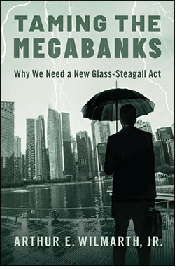 It has been the contention of Wall Street On Parade for more than a decade that today’s so-called “universal banks,” also variously known as megabanks or Global Systemically Important Banks (G-SIBs), are a banking model from hell that was thoroughly discredited in the tens of thousands of transcripts and documents released by the U.S. Senate following its multi-year investigation of that structure in the early 1930s.
It has been the contention of Wall Street On Parade for more than a decade that today’s so-called “universal banks,” also variously known as megabanks or Global Systemically Important Banks (G-SIBs), are a banking model from hell that was thoroughly discredited in the tens of thousands of transcripts and documents released by the U.S. Senate following its multi-year investigation of that structure in the early 1930s.
Now the seminal book proving that theory has been published. Written by Arthur E. Wilmarth, Jr. and titled Taming the Megabanks: Why We Need a New Glass-Steagall Act, the book brilliantly takes the reader through a riveting guided tour covering the past century and the resurrection of this same disastrous U.S. banking model in 1999.
Oxford University Press is the publisher of Wilmarth’s book. We can envision it becoming one of the most important works of this century in providing the impetus for Congress to finally restore the Glass-Steagall Act – the 1933 to 1999 law that mandated the separation of stock trading and stock underwriting firms from federally-insured, deposit-taking banks. That legislation protected the U.S. financial system for 66 years. It took just nine years after its repeal for the universal banks on Wall Street to blow up the financial system in a replay of 1929, taking the U.S. economy along for the gut-wrenching ride.
Wilmarth’s writing is so insightful and profound in its analysis of the similarities between the banks of the late 1920s and today that it feels like the ghost of Ferdinand Pecora might have been whispering in Wilmarth’s ear. Pecora was a former prosecutor from New York who was chosen to preside over much of the early 1930s Senate Banking hearings and investigations of the corrupt Wall Street structure that led to the 1929 crash and Great Depression.
Three banking names that played significant roles in the crash of 1929 and the ensuing Great Depression were National City Bank, JP Morgan, and Chase National Bank. National City Bank was the precursor to today’s Citigroup, the bank that would have collapsed in 2008 except for the largest taxpayer and Federal Reserve bailout in global banking history. JPMorgan and Chase combined in 2000 to create today’s JPMorgan Chase.
Read our full review here.
~~~
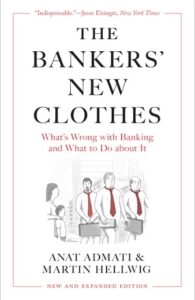 Anat Admati, Professor of Finance and Economics at Stanford Graduate School of Business, and German economist Martin Hellwig, have performed a public service to all Americans with their newly released, updated and expanded book The Bankers’ New Clothes: What’s Wrong with Banking and What to Do about It. It puts the interlocking web of corruption that is mistakenly referred to as the U.S. banking system into a pristinely documented and highly readable book.
Anat Admati, Professor of Finance and Economics at Stanford Graduate School of Business, and German economist Martin Hellwig, have performed a public service to all Americans with their newly released, updated and expanded book The Bankers’ New Clothes: What’s Wrong with Banking and What to Do about It. It puts the interlocking web of corruption that is mistakenly referred to as the U.S. banking system into a pristinely documented and highly readable book.
Let us first explain those men without pants on the book jacket. That provocative graphic comes from the storyline in the Hans Christian Andersen tale “The Emperor’s New Clothes.” Tailors offer to make the emperor magical clothes that will be visible only to smart people and invisible to the stupid and unfit. When the emperor’s ministers go to inspect the clothes, they see nothing, but they are fearful of being called stupid if they admit this. The emperor, also fearful of being regarded as intellectually lacking, says nothing and tours the capitol in his nonexistent garments. Only a child is brave enough to shout out in the capitol “The emperor has no clothes,” thus breaking the conspiracy of silence.
The authors explain in example after example how corruption has taken over the banking system today but the guardians of our democracy have bought into the “pervasive myth that banks and banking are special and different,” so they have allowed themselves to be socialized to silence out of fear of being “declared incompetent to participate in the discussion.”
As I read that insightful analogy, the image of 60 Minutes’ Lesley Stahl treating JPMorgan Chase’s crime boss, Jamie Dimon, like a revered financial wizard in a televised interview in 2019 flashed through my mind. (Less than a year after that program aired, JPMorgan Chase admitted to another two felony counts brought by the U.S. Department of Justice, bringing its total to an unprecedented five felony counts in the span of six years.)
A key area on which Admati and Hellwig shine much needed sunshine is the accounting gimmickry that allows U.S. banks to hide billions of dollars in losses on bonds by simply labeling them “held to maturity” securities. (For background, see here and here.) The authors write that “Accounting rules should be changed so that banks must apply fair-value accounting to all assets regardless of how long they intend to hold them.”
Admati and Hellwig also provide brilliant new insights into the second, third and fourth largest bank failures in U.S. history that occurred in the spring of 2023. Those bank failures resulted in the Federal Reserve creating yet another new bailout program, the Bank Term Funding Program, despite the American people being reassured since 2010 that the Dodd-Frank financial reform legislation ended “too big to fail.”
(Read our full review here.)
~~~
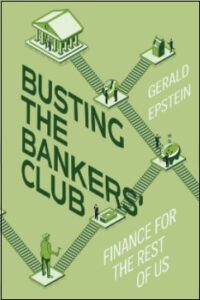 Gerald Epstein is Professor of Economics and a Founding Co-Director of the Political Economy Research Institute (PERI) at the University of Massachusetts, Amherst. A book he has spent the past decade researching and writing was released in January 2024 from the University of California Press: Busting the Bankers’ Club: Finance for the Rest of Us.
Gerald Epstein is Professor of Economics and a Founding Co-Director of the Political Economy Research Institute (PERI) at the University of Massachusetts, Amherst. A book he has spent the past decade researching and writing was released in January 2024 from the University of California Press: Busting the Bankers’ Club: Finance for the Rest of Us.
Anticipation of this book’s release caused some sweaty brows in the halls of Congress, on Wall Street, at Big Law, and in the economics community. That’s because Epstein is naming names – the names of the people who have sold out American democracy and the public interest by becoming sycophants for, or actual members of, the Bankers’ Club.
The Chairman of the Bankers’ Club is the Federal Reserve, writes Epstein. That’s because the Fed has strongarmed its way to becoming both the supervisor of the Wall Street mega banks while also being able to create money at the flip of an electronic switch, which it uses to funnel trillions of dollars in cheap loans to bail out the mega banks behind a dark curtain. Alan Greenspan’s unprecedented 19-year reign as Fed Chair laid the foundation for this power grab while his successor, Ben Bernanke, enshrined the concept of regulator-turned-bailout-kingpin during the 2007 to 2009 financial crisis, (funneling $29 trillion in largesse to prop up a financial structure that had collapsed under the weight of its own corruption).
Read our full review here.
~~~
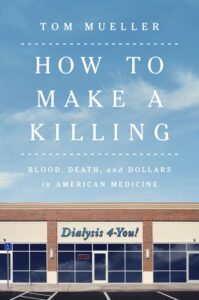 Investigative reporter and author, Tom Mueller, has dedicated his latest book to pulling back the curtain on the dirty underbelly of the kidney dialysis industry. The book, How to Make a Killing: Blood, Death and Dollars in American Medicine, will be available for sale in bookstores on August 1, 2023. If you have a loved one receiving kidney dialysis at centers run by either DaVita or Fresenius, we urge you to stop what you’re doing, buy this book, and read it from cover to cover. The book presents nothing short of an indictment of rabid capitalism run amok, effectively turning what should be a life-saving branch of medicine into a criminal enterprise.
Investigative reporter and author, Tom Mueller, has dedicated his latest book to pulling back the curtain on the dirty underbelly of the kidney dialysis industry. The book, How to Make a Killing: Blood, Death and Dollars in American Medicine, will be available for sale in bookstores on August 1, 2023. If you have a loved one receiving kidney dialysis at centers run by either DaVita or Fresenius, we urge you to stop what you’re doing, buy this book, and read it from cover to cover. The book presents nothing short of an indictment of rabid capitalism run amok, effectively turning what should be a life-saving branch of medicine into a criminal enterprise.
DaVita and Fresenius are a duopoly, controlling about 80 percent of the 6,900 dialysis centers across America, writes Mueller. According to an economist, Ryan McDevitt, who has extensively researched the results of this consolidation and spoke on the record with Mueller, this is what happens when an independent dialysis center is acquired by the duopoly:
“When DaVita and Fresenius acquire independent facilities, they start implementing their best practices, at least from their viewpoint, which means maximizing profits. So they’re pumping patients full of drugs. They’re cutting back staffing ratios. All the things that make a business really profitable and productive, they’re doing. Unfortunately, we find this has severe consequences for patients. Death rates go up, hospitalization rates go up, transplant rates fall, and so on. Any measure that could get worse pretty much got worse, after the big chains acquired independent facilities.”
Read our full review here.
~~~
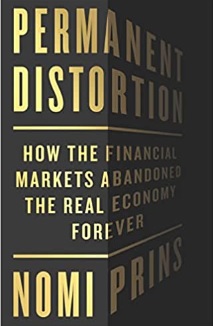 Wall Street veteran Nomi Prins’ new book is being released with a title that should give every member of the Senate Banking and House Financial Services Committees pause: Permanent Distortion: How the Financial Markets Abandoned the Real Economy Forever. The book does what neither of these Committees has done for the American people. It explains how the financial crash of 2008 unleashed an unbridled and unaccountable Fed as Wall Street’s permanent sugar daddy, distorting market functioning with its perpetual money spigot to the point that markets no longer function as a pricing mechanism or efficient allocator of capital but more along the lines of a Ponzi scheme for the rich. Prins writes:
Wall Street veteran Nomi Prins’ new book is being released with a title that should give every member of the Senate Banking and House Financial Services Committees pause: Permanent Distortion: How the Financial Markets Abandoned the Real Economy Forever. The book does what neither of these Committees has done for the American people. It explains how the financial crash of 2008 unleashed an unbridled and unaccountable Fed as Wall Street’s permanent sugar daddy, distorting market functioning with its perpetual money spigot to the point that markets no longer function as a pricing mechanism or efficient allocator of capital but more along the lines of a Ponzi scheme for the rich. Prins writes:
“Once central banks unleashed monetary policy to accommodate mega-banks, subsidize Wall Street financiers, and bolster global markets, the very idea of free and open markets and laissez-faire investing died. The threat of raising rates or ceasing to buy bonds could catalyze panic, instability, and chaos—so the threat was never issued. No one wanted to call the Fed’s QE a Ponzi scheme. But it was.”
Read our full review here.
~~~
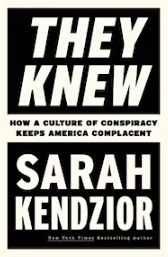 Because Sarah Kendzior was so spot on with her early warnings about Trumpism, her new warnings about the ultimate plan for the United States must be heeded. Kendzior writes in her latest book, They Knew: How a Culture of Conspiracy Keeps America Complacent: “After Trump took office and proceeded to purge agencies, pack courts, and swindle his way into impunity, I warned that his administration was a transnational crime syndicate masquerading as a government. I said this on television and it was not appreciated. In 2017, I warned that he would never leave the White House of his own volition but would instead employ violence to attempt to hold power, even if he lost the election, and that this destructive crusade would continue until the criminal elites surrounding him were held accountable.”
Because Sarah Kendzior was so spot on with her early warnings about Trumpism, her new warnings about the ultimate plan for the United States must be heeded. Kendzior writes in her latest book, They Knew: How a Culture of Conspiracy Keeps America Complacent: “After Trump took office and proceeded to purge agencies, pack courts, and swindle his way into impunity, I warned that his administration was a transnational crime syndicate masquerading as a government. I said this on television and it was not appreciated. In 2017, I warned that he would never leave the White House of his own volition but would instead employ violence to attempt to hold power, even if he lost the election, and that this destructive crusade would continue until the criminal elites surrounding him were held accountable.”
Trump and his cohorts, writes Kendzior, want the U.S. to collapse because a “depopulated, partitioned United States is easier to exploit and control, particularly in a chaotic era of climate change, which they anticipated decades ago. To them, the state is just something to sell. They do not care if the buyers are foreign or domestic. The United States of America is merely a landmass to split into oligarch fiefdoms….” Read our full review here.
~~~
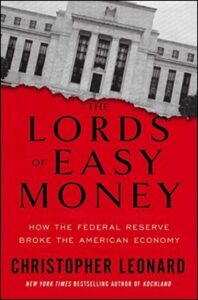 There’s a new book out from Simon & Schuster with the provocative title: The Lords of Easy Money: How the Federal Reserve Broke the American Economy. The book, written by bestselling author Christopher Leonard, is sprinkled with eye popping revelations – particularly in regard to how hedge funds have been able to effectively mint billions by designing trades to take advantage of the Fed’s repo bailouts and quantitative easing.
There’s a new book out from Simon & Schuster with the provocative title: The Lords of Easy Money: How the Federal Reserve Broke the American Economy. The book, written by bestselling author Christopher Leonard, is sprinkled with eye popping revelations – particularly in regard to how hedge funds have been able to effectively mint billions by designing trades to take advantage of the Fed’s repo bailouts and quantitative easing.
Quantitative easing (QE) is a scheme launched by former Fed Chair Ben Bernanke, beginning in November 2008. QE means that the New York Fed, through its open markets desk, buys up Treasury securities and federal-agency-backed Mortgage-Backed Securities (MBS) from its 24 primary dealers. The Fed’s purchases of tens of billions of dollars a month of these securities creates artificial demand that would not otherwise exist, thus lowering the interest rates these securities need to offer, which also puts downward pressure on the interest rates of other debt instruments. This helps to sustain the Fed’s zero-bound interest rate policy on its benchmark rate, the Fed Funds rate. Bernanke promoted the plan as a way to lift asset prices and get the economy growing again after the debilitating effects of the 2008 crash. It’s been the go-to plan of the Fed ever since whenever Wall Street needs a bailout.
Interestingly, a zero-bound interest rate policy has also bailed out the hundreds of trillions of dollars (notional or face amount) of derivatives that Wall Street’s megabanks have waged with questionable counterparties that might, or might not, be able to pay up on the trades if they went sour.
Unfortunately, the dark side of QE, as cleverly detailed in layman’s terms in Leonard’s book, is that it has created a desperate struggle for yield by American savers, pension funds and other typically risk-adverse investors. The book makes the point that the long-term goal of QE was, in fact, to make saving money and expecting to earn a decent interest rate on it a fool’s errand year after year, thus forcing millions of people into riskier and riskier areas of investment, which has led to the unprecedented bubble in markets that we find ourselves in today – with no reliable exit plan by the Fed. Read our full review here.
~~~
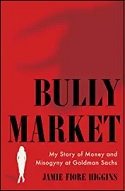 Simon & Schuster will release a new book by Jamie Fiore Higgins, a woman who worked her entire Wall Street career at one firm. Over the span of just under 18 years, beginning on September 2, 1998 and ending officially on May 31, 2016 according to BrokerCheck, Fiore Higgins achieved a level of financial success rarely attained by a woman on Wall Street. She was fresh out of college, at age 22, when this journey began. She was a seven-figure Managing Director at the quintessential good ole boys club on Wall Street when it ended.
Simon & Schuster will release a new book by Jamie Fiore Higgins, a woman who worked her entire Wall Street career at one firm. Over the span of just under 18 years, beginning on September 2, 1998 and ending officially on May 31, 2016 according to BrokerCheck, Fiore Higgins achieved a level of financial success rarely attained by a woman on Wall Street. She was fresh out of college, at age 22, when this journey began. She was a seven-figure Managing Director at the quintessential good ole boys club on Wall Street when it ended.
Now, six years after she resigned her post (possibly heretofore restrained by the customary non-disparagement agreement one is asked to sign when leaving a Wall Street investment bank) Fiore Higgins is spilling the beans on what she saw and heard and experienced at Goldman Sachs. The book title says it all: Bully Market: My Story of Money and Misogyny at Goldman Sachs.
But the book is so much more than the title suggests. Fiore Higgins had a front row seat to one of the most unprecedented time spans in Wall Street history. In fact, the 500-year financial storm was happening again and again during her years at Goldman. Read our full review here.
~~~
As Americans wake up each day to the new dystopian normal and reports of another corporate or Wall Street bailout (no doubt at the 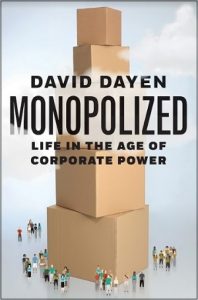 urging of the corporate lobbyists that have embedded themselves in the Trump administration), there is widespread agreement that big corporations have too much power and control in America…
urging of the corporate lobbyists that have embedded themselves in the Trump administration), there is widespread agreement that big corporations have too much power and control in America…
Against this backdrop comes a very welcome new book from David Dayen: Monopolized: Life in the Age of Corporate Power. Dayen is Executive Editor of American Prospect and one of the most admired and prolific financial writers in America.
If you think the book title sounds like a dry treatise on anti-trust law, think again. Dayen has brilliantly humanized this book by allowing the reader to step inside the personal lives of everyday Americans who are attempting to navigate and financially survive the corporatization of their country. Read our full review here.
~~~
In Crisis of Conscience: Whistleblowing in an Age of Fraud, Tom Mueller builds an incontrovertible case that the United States has 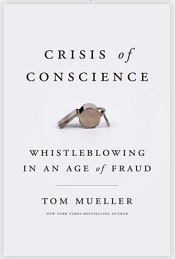 become a dystopian society where almost every government entity that a citizen would typically turn to for redress over a lawless act has been corrupted by greed, pay to play, revolving doors, political bribes, or self-dealing. Adding poignant authenticity to this premise, the book arrives at a time when the highest elected official (President Donald Trump) and the highest law enforcement officer (Attorney General William Barr) are under a serious House of Representatives inquiry based on documents provided by a whistleblower. Read our full review here.
become a dystopian society where almost every government entity that a citizen would typically turn to for redress over a lawless act has been corrupted by greed, pay to play, revolving doors, political bribes, or self-dealing. Adding poignant authenticity to this premise, the book arrives at a time when the highest elected official (President Donald Trump) and the highest law enforcement officer (Attorney General William Barr) are under a serious House of Representatives inquiry based on documents provided by a whistleblower. Read our full review here.
~~~
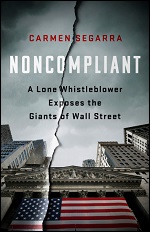 The underlying theme that Wall Street’s Federal regulators have become whores for the industry permeates most of the well-researched books that have been written about Wall Street over the past decade. But no book has connected the dots to the nuances and subtleties of how this whoring works as effectively as Noncompliant: A Lone Whistleblower Exposes the Giants of Wall Street. Written by Carmen Segarra, the petite lawyer turned bank examiner turned whistleblower turned one-woman swat team, the 340-page tome takes the reader along on her gut-wrenching workdays for an entire seven months inside one of the most powerful and corrupted watchdogs of the powerful and corrupted players on Wall Street – the Federal Reserve Bank of New York. Read our full review here.
The underlying theme that Wall Street’s Federal regulators have become whores for the industry permeates most of the well-researched books that have been written about Wall Street over the past decade. But no book has connected the dots to the nuances and subtleties of how this whoring works as effectively as Noncompliant: A Lone Whistleblower Exposes the Giants of Wall Street. Written by Carmen Segarra, the petite lawyer turned bank examiner turned whistleblower turned one-woman swat team, the 340-page tome takes the reader along on her gut-wrenching workdays for an entire seven months inside one of the most powerful and corrupted watchdogs of the powerful and corrupted players on Wall Street – the Federal Reserve Bank of New York. Read our full review here.
~~~
In Birth Strike: The Hidden Fight Over Women’s Work, Jenny Brown performs a brilliant forensic examination of the money and people behind the stealth agenda to raise the low birth rate in the United States. That agenda includes concerted campaigns against abortion, the “morning-after pill” and other forms of 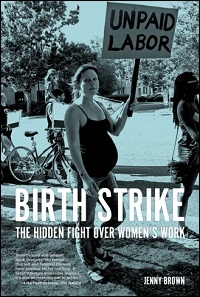 contraception. Using exhaustive research, Brown convincingly makes the case that it’s a well-financed corporate agenda implanted in Washington with an end goal of putting more American women in the maternity ward.
contraception. Using exhaustive research, Brown convincingly makes the case that it’s a well-financed corporate agenda implanted in Washington with an end goal of putting more American women in the maternity ward.
It’s not a cultural or religious agenda as many people believe. It’s just about money – corporate profits to be more specific. More babies mean more workers and more workers mean cheaper labor because there is no shortage of supply and thus no bargaining power for higher wages. (In that respect, it’s akin to why corporations spent decades undermining the right to unionize. Without a union, the individual worker has little negotiating power for higher wages, benefits or a shorter work week.) Read our full review here.
~~~
Written by Judy Robinett, Crack the Funding Code: How Investors Think and What They Need to Hear to Fund Your Startup is the how-to guide for young business owners to tap into private capital sources like angel investors or 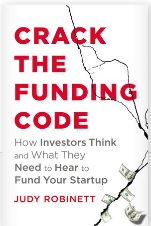 venture capitalists.
venture capitalists.
There are key sections in the book on how to find the people who can help you, how to write a solid business plan, financial statement and projections, and a compelling pitch. Equally important for the unsophisticated but creative entrepreneur, the book offers sound advice on hiring a lawyer to evaluate the deal’s terms and when to say no and walk away from potential outside investors. Read our full review here.
~~~
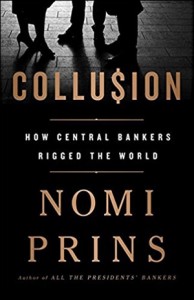 Collusion by Nomi Prins not only proves that the 1 percent got bailed out while the 99 percent got sold out as a result of policies of the U.S. Central Bank (the Fed) during and after the financial crash of 2008, but it makes the powerful argument that another epic financial crash is inevitable under the current mega bank structure which has turned the Federal Reserve into little more than a money pimp (our term) for the Wall Street casino.
Collusion by Nomi Prins not only proves that the 1 percent got bailed out while the 99 percent got sold out as a result of policies of the U.S. Central Bank (the Fed) during and after the financial crash of 2008, but it makes the powerful argument that another epic financial crash is inevitable under the current mega bank structure which has turned the Federal Reserve into little more than a money pimp (our term) for the Wall Street casino.
Prins writes that “Eight years after the crisis began, the Big Six US banks – JPMorgan Chase, Citigroup, Wells Fargo, Bank of America, Goldman Sachs, and Morgan Stanley – collectively held 43 percent more deposits, 84 percent more assets, and triple the amount of cash they held before. The Fed has allowed the biggest banks on Wall Street to essentially double the risk that devastated the system in 2008.” Read our full review here.
~~~
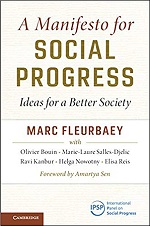 A step-by-step guide has been published on how to defeat the new-age robber barons, the corporate structure that made them billionaires while leaving workers with crumbs, and the enshrined political system that marches to the crack of their unaccountable whip.
A step-by-step guide has been published on how to defeat the new-age robber barons, the corporate structure that made them billionaires while leaving workers with crumbs, and the enshrined political system that marches to the crack of their unaccountable whip.
Released by Cambridge University Press on August 31, the book is titled “A Manifesto for Social Progress: Ideas for a Better Society,” by Marc Fleurbaey, Professor in Economics and Humanistic Studies at Princeton University and a prolific social justice author. Reading the book feels like finding a large flashlight after endless days of stumbling around in a dark cave. Read our full review here.
~~~
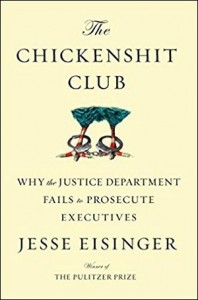 Last year Simon & Schuster released The Chickenshit Club: Why the Justice Department Fails to Prosecute Executives by the Pulitzer Prize winning journalist at ProPublica, Jesse Eisinger. If you read nothing else this summer, you should read this book followed by Nomi Prins’ Collusion: How Central Bankers Rigged the World. The two books provide Americans with a comprehensive understanding of how the Justice Department, Federal regulators, a growing number of Federal judges and the central bank of the United States known as the Federal Reserve have been corrupted by corporate influence. To a large degree, they now serve their corporate masters, not the American people. Continue reading here.
Last year Simon & Schuster released The Chickenshit Club: Why the Justice Department Fails to Prosecute Executives by the Pulitzer Prize winning journalist at ProPublica, Jesse Eisinger. If you read nothing else this summer, you should read this book followed by Nomi Prins’ Collusion: How Central Bankers Rigged the World. The two books provide Americans with a comprehensive understanding of how the Justice Department, Federal regulators, a growing number of Federal judges and the central bank of the United States known as the Federal Reserve have been corrupted by corporate influence. To a large degree, they now serve their corporate masters, not the American people. Continue reading here.
~~~
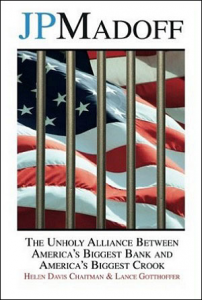 Two interesting things happened this week in Jamie Dimon’s world: two gutsy attorneys, Helen Davis Chaitman and Lance Gotthoffer, published a book comparing JPMorgan Chase to the Gambino crime family, explaining how the bank could and should be prosecuted under RICO statutes for serial frauds against the investing public. Taking a diametrically different tack, Bloomberg Markets magazine editor, Joel Weber, fawned over Dimon in a Bloomberg TV interview, repeatedly asserting that Jamie Dimon is all about the customer…Unfortunately for Dimon, attorneys Chaitman and Gotthoffer have no such lapse of memory. In their newly published book, JPMadoff: The Unholy Alliance between America’s Biggest Bank and America’s Biggest Crook, they provide a rap sheet of exactly how JPMorgan has been “taking care” of its customers under Dimon’s oversight. Read the rest of our article here.
Two interesting things happened this week in Jamie Dimon’s world: two gutsy attorneys, Helen Davis Chaitman and Lance Gotthoffer, published a book comparing JPMorgan Chase to the Gambino crime family, explaining how the bank could and should be prosecuted under RICO statutes for serial frauds against the investing public. Taking a diametrically different tack, Bloomberg Markets magazine editor, Joel Weber, fawned over Dimon in a Bloomberg TV interview, repeatedly asserting that Jamie Dimon is all about the customer…Unfortunately for Dimon, attorneys Chaitman and Gotthoffer have no such lapse of memory. In their newly published book, JPMadoff: The Unholy Alliance between America’s Biggest Bank and America’s Biggest Crook, they provide a rap sheet of exactly how JPMorgan has been “taking care” of its customers under Dimon’s oversight. Read the rest of our article here.
~~~
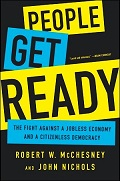 Landing in the midst of the most critical election season since the New Deal era of the 30s, comes a masterpiece of labor history and political strategy from the prolific author, Robert W. McChesney, and John Nichols, the popular national affairs correspondent at The Nation. Both McChesney and Nichols are co-founders of Free Press, a national media reform organization. People Get Ready: The Fight Against a Jobless Economy and a Citizenless Democracy provides the reader with, first, an exquisite understanding of how the U.S. evolved into a society where the citizen has been kicked to the curb in their “democracy” and, next, a strategic road map for a peaceful revolution. The authors write that “The United States retains the façade of democracy. It remains a democracy on paper and in our hearts. But ours is, increasingly, a citizenless democracy…Oligarchs and their servants call the shots for the feudal serfs of corporate capital.” Read the rest of our review here.
Landing in the midst of the most critical election season since the New Deal era of the 30s, comes a masterpiece of labor history and political strategy from the prolific author, Robert W. McChesney, and John Nichols, the popular national affairs correspondent at The Nation. Both McChesney and Nichols are co-founders of Free Press, a national media reform organization. People Get Ready: The Fight Against a Jobless Economy and a Citizenless Democracy provides the reader with, first, an exquisite understanding of how the U.S. evolved into a society where the citizen has been kicked to the curb in their “democracy” and, next, a strategic road map for a peaceful revolution. The authors write that “The United States retains the façade of democracy. It remains a democracy on paper and in our hearts. But ours is, increasingly, a citizenless democracy…Oligarchs and their servants call the shots for the feudal serfs of corporate capital.” Read the rest of our review here.
~~~
Fixers: At Wall Street On Parade we call it continuity government. Michael M. Thomas,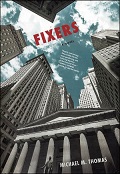 in a new book of quasi-fiction, calls it Fixers, the idea that no matter who comes and goes in the Oval Office, Wall Street has a fix in to make sure it is protected. The Thomas book could not come at a more inconvenient time for outgoing President Obama and the next leg of the continuity government that Wall Street hopes to install in the White House – otherwise known as Hillary Clinton. Read the rest of our review here.
in a new book of quasi-fiction, calls it Fixers, the idea that no matter who comes and goes in the Oval Office, Wall Street has a fix in to make sure it is protected. The Thomas book could not come at a more inconvenient time for outgoing President Obama and the next leg of the continuity government that Wall Street hopes to install in the White House – otherwise known as Hillary Clinton. Read the rest of our review here.
~~~
In his book, Other People’s Money: The Real Business of Finance, economist John Kay demonstrates not only a sagacious understanding of the grotesque underpinnings of financial markets but he maps out a series of common sense, structural r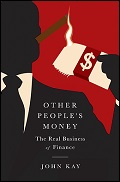 eforms to bring the financial industry back to its key mandates: efficient allocation of capital and honest handling of other people’s money. From beginning to end, Kay peels back the crass hypocrisy of the market overseers, writing that much of what the financial sector does “contributes little, if anything, to the betterment of lives and the efficiency of business. And yet many things that finance could do to advance these social and economic goals are not done well – or in some cases at all.” Read our full review here.
eforms to bring the financial industry back to its key mandates: efficient allocation of capital and honest handling of other people’s money. From beginning to end, Kay peels back the crass hypocrisy of the market overseers, writing that much of what the financial sector does “contributes little, if anything, to the betterment of lives and the efficiency of business. And yet many things that finance could do to advance these social and economic goals are not done well – or in some cases at all.” Read our full review here.
~~~
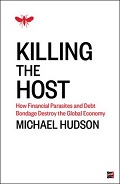 Killing the Host, by economist and financial writer Michael Hudson, hones an exquisitely gripping journey from Wall Street’s original role as capital allocator to its present-day parasitism that has replaced U.S. capitalism as an entrenched, politically-enforced economic model across America. This book is a must-read for anyone hoping to escape the most corrupt era in American history with a shirt still on his parasite-riddled back. Read our full review here.
Killing the Host, by economist and financial writer Michael Hudson, hones an exquisitely gripping journey from Wall Street’s original role as capital allocator to its present-day parasitism that has replaced U.S. capitalism as an entrenched, politically-enforced economic model across America. This book is a must-read for anyone hoping to escape the most corrupt era in American history with a shirt still on his parasite-riddled back. Read our full review here.
~~~
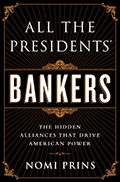 “All the Presidents’ Bankers: The Hidden Alliances that Drive American Power” by former Wall Street veteran, Nomi Prins, is a seminal addition to the history of continuity government between the White House and Wall Street from the days of Teddy Roosevelt and the Panic of 1907 right up through the Panic of 2008 and the Presidency of Barack Obama. (Don’t be intimidated by the 69 pages of footnotes; while meticulously researched, this is a captivating read for anyone seeking clarity on why Wall Street can collapse, get bailed out by the taxpayer, cause a Great Recession and still call the shots in Washington.) Read the rest of the review here.
“All the Presidents’ Bankers: The Hidden Alliances that Drive American Power” by former Wall Street veteran, Nomi Prins, is a seminal addition to the history of continuity government between the White House and Wall Street from the days of Teddy Roosevelt and the Panic of 1907 right up through the Panic of 2008 and the Presidency of Barack Obama. (Don’t be intimidated by the 69 pages of footnotes; while meticulously researched, this is a captivating read for anyone seeking clarity on why Wall Street can collapse, get bailed out by the taxpayer, cause a Great Recession and still call the shots in Washington.) Read the rest of the review here.
~~~
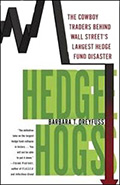 Hedge Hogs: The Cowboy Traders Behind Wall Street’s Largest Hedge Fund Disaster: The Barbara Dreyfuss book is the fast moving and riveting account of Amaranth Advisors LLC, the hedge fund that went from holding $9.668 billion in client assets in August 2006 to flaming out in losses exceeding $6 billion in less than four weeks; the culprit – out of control energy trading and efforts to rig the market according to the government.
Hedge Hogs: The Cowboy Traders Behind Wall Street’s Largest Hedge Fund Disaster: The Barbara Dreyfuss book is the fast moving and riveting account of Amaranth Advisors LLC, the hedge fund that went from holding $9.668 billion in client assets in August 2006 to flaming out in losses exceeding $6 billion in less than four weeks; the culprit – out of control energy trading and efforts to rig the market according to the government.
~~~
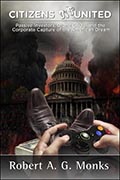 Robert A.G. Monks has written a very dangerous book, Citizens DisUnited: Passive Investors, Drone CEOs, and the Corporate Capture of the American Dream. Grab two copies of this book as fast as you can: put one out to sea in a watertight bottle for future archeologists to piece together the downfall of America; put another in a safe in your home. If things continue on the path we’re on, corporations will be rounding up books like this for bonfires.
Robert A.G. Monks has written a very dangerous book, Citizens DisUnited: Passive Investors, Drone CEOs, and the Corporate Capture of the American Dream. Grab two copies of this book as fast as you can: put one out to sea in a watertight bottle for future archeologists to piece together the downfall of America; put another in a safe in your home. If things continue on the path we’re on, corporations will be rounding up books like this for bonfires.
~~~
Ayn Rand Nation: The Hidden Struggle for America’s Soul, removes the propaganda mask that has been so adroitly affixed to Alan Greenspan’s page-boy coiffed goddess of laissez-faire capitalism and the Tea Party’s mother ship. 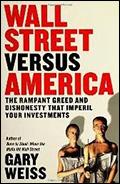 The book is written by Gary Weiss, long time Wall Street reporter and author, and released by St. Martin’s Press. Two years before the financial crisis, Weiss sounded the alarm in Wall Street Versus America – a must read for anyone serious about putting the pieces together.
The book is written by Gary Weiss, long time Wall Street reporter and author, and released by St. Martin’s Press. Two years before the financial crisis, Weiss sounded the alarm in Wall Street Versus America – a must read for anyone serious about putting the pieces together.
~~~
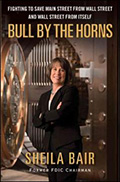 Bull by the Horns: Sheila Bair, the ultimate insider as former head of the FDIC during the financial crisis, has performed a microscopic job on former Treasury Secretary, Tim Geithner, in her book, Bull by the Horns. The image that emerges is a two-headed monster: a regulator functioning as a Citigroup messenger boy and an insanely mismanaged bank that was somehow able to shield from public scrutiny the fact that it had a measly $125 billion in U.S. insured deposits while turning government on its head and raking in over $2.5 trillion in taxpayer capital, guarantees and loans.
Bull by the Horns: Sheila Bair, the ultimate insider as former head of the FDIC during the financial crisis, has performed a microscopic job on former Treasury Secretary, Tim Geithner, in her book, Bull by the Horns. The image that emerges is a two-headed monster: a regulator functioning as a Citigroup messenger boy and an insanely mismanaged bank that was somehow able to shield from public scrutiny the fact that it had a measly $125 billion in U.S. insured deposits while turning government on its head and raking in over $2.5 trillion in taxpayer capital, guarantees and loans.
~~~
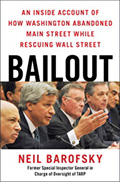 Neil Barofsky, the former Special Inspector General of the Troubled Asset Relief Program (SIG-TARP), has penned a humdinger. Bailout: An Inside Account of How Washington Abandoned Main Street While Rescuing Wall Street, confirms what we’ve suspected since U.S. Treasury Secretary Tim Geithner appointed Mark Patterson, a Goldman Sachs lobbyist, to be his Chief of Staff – that the U.S. Treasury Department has become Wall Street West.
Neil Barofsky, the former Special Inspector General of the Troubled Asset Relief Program (SIG-TARP), has penned a humdinger. Bailout: An Inside Account of How Washington Abandoned Main Street While Rescuing Wall Street, confirms what we’ve suspected since U.S. Treasury Secretary Tim Geithner appointed Mark Patterson, a Goldman Sachs lobbyist, to be his Chief of Staff – that the U.S. Treasury Department has become Wall Street West.
~~~
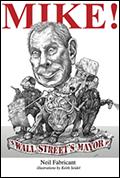 Neil Fabricant, president emeritus of the George Washington University Graduate School of Political Management and lifetime New Yorker, has penned a take-your-breath-away expose on the heretofore inscrutable Mayor of New York City, Michael Bloomberg. Mike! Wall Street’s Mayor, is sharp, witty, and pulls no punches when it comes to the billionaire 1 percenter out to portray himself as the man of the people, while growing his estimated $3 billion personal wealth to $22 billion while in office.
Neil Fabricant, president emeritus of the George Washington University Graduate School of Political Management and lifetime New Yorker, has penned a take-your-breath-away expose on the heretofore inscrutable Mayor of New York City, Michael Bloomberg. Mike! Wall Street’s Mayor, is sharp, witty, and pulls no punches when it comes to the billionaire 1 percenter out to portray himself as the man of the people, while growing his estimated $3 billion personal wealth to $22 billion while in office.
~~~
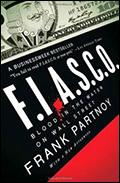 Frank Partnoy has an insider’s feel for his topics – he worked in the 90s as a derivatives structurer at Morgan Stanley and CS First Boston and wrote the Wall Street classic, F.I.A.S.C.O.: Blood in the Water on Wall Street. Another great read from Partnoy is Infectious Greed: How Deceit and Risk Corrupted the Financial Markets. Now a professor of law and finance at the University of San Diego, Partnoy takes a fascinating look at timing decisions for maximum advantage in Wait: The Art and Science of Delay.
Frank Partnoy has an insider’s feel for his topics – he worked in the 90s as a derivatives structurer at Morgan Stanley and CS First Boston and wrote the Wall Street classic, F.I.A.S.C.O.: Blood in the Water on Wall Street. Another great read from Partnoy is Infectious Greed: How Deceit and Risk Corrupted the Financial Markets. Now a professor of law and finance at the University of San Diego, Partnoy takes a fascinating look at timing decisions for maximum advantage in Wait: The Art and Science of Delay.
~~~
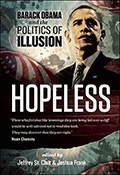 There are dozens of writers in America who were highly skeptical of candidate Obama’s inexplicable, cult-like rise to the top of the Democratic party. Their work is bound together in Hopeless: Barack Obama and the Politics of Illusion, edited by Jeffrey St. Clair and Joshua Frank. (An article by Pam Martens, Editor of this web site, Obama’s Money Cartel, is included in the anthology.)
There are dozens of writers in America who were highly skeptical of candidate Obama’s inexplicable, cult-like rise to the top of the Democratic party. Their work is bound together in Hopeless: Barack Obama and the Politics of Illusion, edited by Jeffrey St. Clair and Joshua Frank. (An article by Pam Martens, Editor of this web site, Obama’s Money Cartel, is included in the anthology.)


